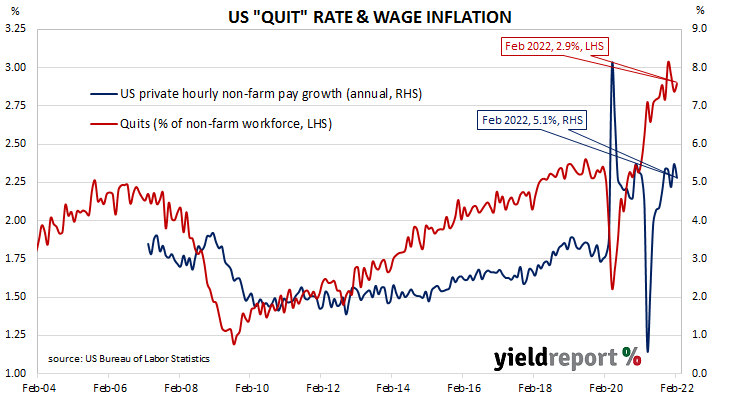Summary: US quit rate up in February; quits up, job openings down, separations up; openings remain at high level, “labour market should remain strong”.
The number of US employees who quit their jobs as a percentage of total employment increased slowly but steadily after the GFC. It peaked in March 2019 and then tracked sideways until virus containment measures were introduced in March 2020. The quit rate then plummeted as alternative employment opportunities rapidly dried up. Following the easing of US pandemic restrictions, it proceeded to recover back to its pre-pandemic rate in the third quarter of 2020 before trending higher through 2021.
Figures released as part of the most recent Job Openings and Labor Turnover Survey (JOLTS) report show the quit rate ticked up in February. 2.9% of the non-farm workforce left their jobs voluntarily, up from January’s figure of 2.8%. There were 94,000 more quits during the month and an additional 548,000 people employed in the non-farm sector.
Short-term US Treasury yields moved higher while longer-term yields fell. By the close of business, the 2-year Treasury bond yield had gained 4bps to 2.37%, the 10-year yield had shed 6bps to 2.40% while the 30-year yield finished 5bps lower at 2.50%.
In terms of US Fed policy, expectations for a higher federal funds rate over the next 12 months softened. At the close of business, May contracts implied an effective federal funds rate of 0.725%, 40bps higher than the current spot rate. July contracts implied 1.25% and March 2023 futures contracts implied an effective federal funds rate of 2.66%, 233bps above the spot rate.
The rise in total quits was led by 74,000 more resignations in the “Retail” sector. The “Finance and insurance” sector experienced the single largest fall, declining by 30,000. Overall, the total number of quits for the month rose from January’s revised figure of 4.258 million to 4.352 million.
Total vacancies at the end of February decreased by 17,000, or 0.2%, from January’s revised figure of 11.283 million to 11.266 million. The fall was driven by a 63,000 decrease in the “Finance and insurance” sector and a 61,000 decrease in the “Other services” sector. The “Health care and social assistance” sector experienced the single largest increase, rising by 54,000. Overall, 9 out of 18 sectors experienced fewer job openings than in the previous month.
In contrast, total separations increased by 48,000, or 0.8%, from January’s revised figure of 6.044 million to 6.092 million. The rise was led by the “Retail trade” sector where there were 85,000 more separations than in January. Separations increased in 7 out of 18 sectors.
“US job openings decreased marginally in February but remain at a high level indicating the labour market should remain strong,” said ANZ senior economist Catherine Birch.
The “quit” rate time series produced by the JOLTS report is a leading indicator of US hourly pay. As wages account for around 55% of a product’s or service’s price in the US, wage inflation and overall inflation rates tend to be closely related. Former Federal Reserve chief and current Treasury Secretary Janet Yellen was known to pay close attention to it.


